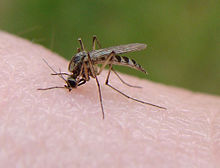- Bite
-
Bite Classification and external resources 
A dog exhibiting his teeth.ICD-10 T14.1 ICD-9 E906.5 MeSH D001733 A bite is a wound received from the mouth (and in particular, the teeth) of an animal, including humans. Animals may bite in self-defense, in an attempt to predate food, as well as part of normal interactions. Other bite attacks may be apparently unprovoked. Self inflicted bites occur in some genetic illnesses such as Lesch-Nyhan syndrome. Biting is an act that occurs when an animal uses its teeth to pierce another object, including food, flesh and inanimate matter. A person bitten by an animal potentially carrying parvovirus or rabies virus should consult a medical doctor immediately. A bite victim may also incur serious bacterial infections of the bone called osteomyelitis which can become life threatening if untreated, whether or not the animal has parvovirus or rabies virus.
Contents
Classification
Bites are usually classified by the type of creature causing the wound. Many different creatures are known to bite humans.
Arthropods
- Spider bite
- Insect bites and stings
- Flea bites are responsible for the transmission of bubonic plague.
- Mosquito bites are responsible for the transmission of dengue fever and malaria.
Vertebrates other than humans
- Bites from dogs are commonplace, with children the most common victims and the face the most common target.[1] About 4.7 million dog bites are reported annually in the United States.[2]
- Other companion animals, including cats, ferrets, and parrots, may bite humans.
- Wildlife may sometimes bite humans. The bites of various mammals such as bats, rabbits, wolves, raccoons, etc. may transmit rabies, which is almost always fatal if left untreated.[citation needed]
Human bites
Injuries from human bites present a particular risk to other humans, with a major risk of sepsis from infection by human oral ecology and the possibility of transmission of blood-borne diseases including, syphilis and hepatitis.
Involuntary biting injuries due to closed-fist injuries from fists striking teeth (referred to as reverse bite injuries) are a common consequence of fist fights. These have been termed "fight bites". Injuries in which the knuckle joints or tendons of the hand are bitten into tend to be the most serious.
In spite of their name, love bites are not biting injuries (they involve bruising from sucking, and the skin is not broken), although actual biting injuries are sometimes seen as the result of fetishistic activities.
Other
- Snakebite
- Leech bite
Signs and symptoms
Bite wounds raise a number of medical concerns for the physician or first aider including:
- Generalized tissue damage due to tearing and scratching.
- Serious hemorrhage if major blood vessels are pierced.
- Infection by bacteria or other pathogens, including rabies.
- Introduction of venom into the wound by venomous animals such as some snakes.
- Introduction of other irritants into the wound, causing inflammation and itching.
Treatment
Bite wounds should be cleaned and debrided as necessary but not closed. Ampicillin/sulbactam is indicated as HACEK endocarditis is the most worrying complication. A punctate wound over a joint surface should be regarded as an open joint injury until proven otherwise.
Treatment
Bite wounds are washed, ideally with povidone-iodine soap and water. The injury is then loosely bandaged, but is not sutured due to risk of infection.
Antibiotics
Antibiotics prophylaxis is recommended for dog and cat bites of the hand[3] and human bites if they are more than superficial.[4] Evidence for the need for antibiotic prophylaxis for bites in other areas inconclusive.[5]
For empirical therapy, the first choice is amoxicillin with clavulanic acid, and if the person is penicillin allergy doxycycline and metronidazole.[4] The anti-staphylococcal penicillins (e.g., cloxacillin, nafcillin, flucloxacillin) and the macrolides (e.g., erythromycin, clarithromycin) are not used for empirical therapy, because they do not cover Pasteurella species.[4]
Rabies
Animal bites inflicted by some animals, including carnivorans and bats can transmit rabies. The animal is caught alive or dead with its head preserved, so the head can later be analyzed to detect the disease. Signs of rabies include foaming at the mouth, self-mutilation, growling, jerky behavior, and red eyes. If the animal lives for ten days and does not develop rabies, then it is probable that no infection has occurred.
If the animal cannot be captured, prophylactic rabies treatment is recommended in most places. Certain places, such as Hawaii, Australia and the United Kingdom, are known not to have native rabies. Treatment is generally available in North America and the Northern European states.
Tetanus
Tetanus toxoid is indicated for virtually any bite that punctures the epidermis and tetanus immune globulin is indicated in patients with more than 10 years since prior vaccination. Tetanus boosters (Td) should be given every ten years.
Prior toxoid Clean minor wounds All other wounds <3 doses TT: yes, TIG: no TT: yes, TIG: yes ≥3 doses TT: if last dose ≥ 10yr
TIG: noTT: if last dose ≥ 5yr, TIG: no TT = Tetanus Toxoid; TIG: Tetanus Immune globulin
Mosquito bites
Antihistamines are effective treatment for the symptoms from bites.[6] Many diseases such as malaria are transmitted by mosquitoes.
Behavior
Biting is an age appropriate behavior and reaction for children 2.5 years and younger. Conversely children above this age have verbal skills to explain their needs and dislikes and biting is not age appropriate. Biting may be prevented by methods including redirection, changing the environment and responding to biting by talking about appropriate ways to express anger and frustration. School age children, those older than 2.5 years, who habitually bite may require professional help. [7]
Biting is also a behavior found in many adult animals (including humans), often as part of sexual arousal. Some discussion of human biting appears in The Kinsey Report on Sexual Behavior in the Human Female.
See also
- Bite force quotient
- The Bite Fight
- Wilderness first aid
References
- ^ Kenneth M. Phillips (2009-12-27). "Dog Bite Statistics". http://www.dogbitelaw.com/PAGES/statistics.html. Retrieved 2010-08-06.
- ^ Questions and Answers about Dog Bites
- ^ "BestBets: Antibiotics in cat bites". http://www.bestbets.org/bets/bet.php?id=1021.
- ^ a b c Oehler RL, Velez AP, Mizrachi M, Lamarche J, Gompf S (2009). "Bite-related and septic syndrome caused by cats and dogs". Lancet Infect Dis 9 (7): 439–47. doi:10.1016/S1473-3099(09)70110-0. PMID 19555903.
- ^ Medeiros I, Saconato H (2001). Medeiros, Iara Marques. ed. "Antibiotic prophylaxis for mammalian bites". Cochrane Database Syst Rev (2): CD001738. doi:10.1002/14651858.CD001738. PMID 11406003.
- ^ "BestBets: Oral antihistamines for insect bites". http://www.bestbets.org/bets/bet.php?id=1074.
- ^ Child Care Links, "How to Handle Biting", retrieved 14 August 2007
External links
General wounds and injuries (T08-T35, 870-949) General Wound/
traumaBlister (Blood blister • Coma blister • Delayed blister • Edema blister • Fracture blister • Friction blister • Sucking blister)
Bruise/Hematoma/Ecchymosis (Battle's sign, Raccoon eyes, Black eye, Subungual hematoma, Cullen's sign, Grey Turner's sign, Retroperitoneal hemorrhage)
Animal bite: Insect bite · Spider biteAnimal bite: Snakebite · Lizard bite
Ballistic traumaForeign body Other By region Animal bites and stings (X20, E900-E909) Animal bites and stings Arthropod bites and stings: Arachnid (Scorpion sting, Spider bite/Arachnidism) · Insect bites and stings (Pulicosis, Reduviid bite, Cimicosis, Ant sting, Bee sting) · Myriapoda (Centipede bite, Millipede burn)
Vertebrate: Dog bite · Snakebite · Lizard bite · Stingray injury · Stonefish sting · Shark attack · Crocodile attack · Bear attack · Wolf attack · Tiger attack · Cougar attack · Dingo attack · Killer whale attack
Other: Jellyfish sting/Jellyfish dermatitis (Coral dermatitis, Hydroid dermatitis, Portuguese man-of-war dermatitis, Sea anemone dermatitis, Seabather's eruption)Categories:- Veterinary medicine
- Pain infliction methods
- Injuries
Wikimedia Foundation. 2010.

